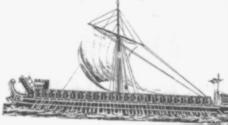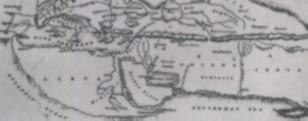Pyramids In The Pacific

The Unwritten History Of Australia
Chapter 17
|
Roman voyages to 'Terra
Incognita'
|
"One day vast new lands will
offer themselves to human view."
Seneca {4 BC 65 AD}
|
Chapter
17 Images
|

|
Roman Trieme 260 BC
This great civilisation, whose ships of trade would reach out beyond the Mediterranean waters to seek riches in the Indian Ocean, had its beginnings in the Stone Age; for the area {Latium} where the modern city of Rome now stands, on the southern bank of the Tiber River, was once the domain of primitive humans, as evidenced by ancient occupation sites, where large numbers of stone implements and human remains have been recovered by archaeologists, dating back 30,000 years BP {before present}.
By around 4000 BC a more advanced flint and copper tool making people entered the region, displacing the earlier primitive inhabitants. They in turn would, about 1600 BC, be replaced by yet another, even more advanced race of semi pastoral, pottery and bronze implement manufacturing people who took care in the disposal of thier dead. They occupied both sides of the Apennines mountain range, over an area extending from the Po Valley in the north, to Etruria in the south as far down as the river Tiber and the site of modern Rome.
Known as the Etruscan, this culture spread along the south bank of the Tiber beginning around 1400 BC, eventually moving into Rome itself. The people occupying the site of Rome at this time apparently spoke an Indo-Aryan language which eventually evolved into a Latin tongue. This Bronze Age people occupied the site from around the 2nd millennium BC onwards, eventually to be joined by others from the Latium area {now the southern part of Lazio}.
Then some time before 1000 BC, these people were in turn absorbed by others of mixed racial origin from the Balkans, who arrived in water craft, speaking a Latin dialect. Workers in Bronze, they cremated thier dead and introduced the plow and other farming techniques. They eventually turned to manufacturing iron implements after learning this skill from people in the Aegean region, and became a dominant Iron Age culture. At one time the city of Rome was largely peopled by Etruscans.
They created city states during the 7th and 6th centuries BC, in an area roughly comprising the territories of southern Tuscany and Lazion, extending about 200 miles from the Arno river to the Tiber, inland to the Apennine mountains. The Etruscans called themselves the 'rasenna'. Their advanced irrigation technology, art, gold and other jewellery they manufactured, as well as their architecture, are strongly near-eastern in features. The city of Rome was situated on the route southwards to the Campanian plain, a very fertile area for the Etruscan farmers.
However, Greek colonists had already beaten them there in the 8th century BC. The Greeks settled in the Bay of Naples, then known as Cumae. Here they developed a great grain and salt trade centre, from where Greek cultural influence was spread through much of southern Italy and Sicily. Throughout the 8th and 7th centuries, the Celts, having moved out of central Europe, entered Spain and Britain, and in the 5th century BC crossed the Alps and drove out the Etruscans from most of northern Italy.
After this event the name 'gaul' was given to this side of the Alps. Etruscans developed a flourishing industry in the manufacture of fine jewellery, as well as everyday items of bronze and other precious metals. They also introduced the alphabet. Yet Etruscan rule of Latium would eventually be eclipsed by the growth of Rome. At first ruled by a monarchy, this city state became a republic about 500 BC....
You brought the nations one great fatherland,
You raised the savage with your taming hand,
Broke him, but gave him laws to be his aid.
A city of the scattered Earth you made."
Claudius Rutilius Namatianus
5th century AD

|
Stradobro World map 20 AD